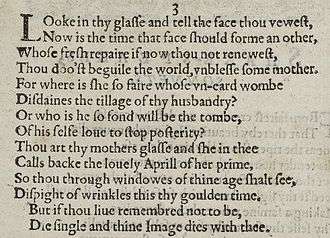Sonnet 3
| Sonnet 3 | |||||||
|---|---|---|---|---|---|---|---|
 Sonnet 3 in the 1609 Quarto | |||||||
|
| |||||||
| |||||||
Sonnet 3 is one of 154 sonnets written by the English playwright and poet William Shakespeare. It is a procreation sonnet within the Fair Youth sequence.
In the sonnet, the speaker is urging the man to whom he is writing to not waste his beauty by not having children. The intended recipient of this and other sonnets is a subject of scholarly debate, with some believing it to be William Herbert and others Henry Wriothesley, as well as other candidates.
The poem is typical of a Shakespearean sonnet in its form: fourteen decasyllabic lines, consisting of three quatrains and a concluding rhyming couplet.
Structure
Sonnet 3 is a typical Shakespearean or English sonnet. Shakespearean sonnets consist of three quatrains followed by a couplet, all in iambic pentameter and following the form's rhyme scheme: abab cdcd efef gg. Each line of the first quatrain of Sonnet 3 exhibits a final extrametrical syllable or feminine ending. The first line additionally exhibits an initial reversal:
/ × × / × / × / × / (×) Look in thy glass and tell the face thou viewest (3.1)
- / = ictus, a metrically strong syllabic position. × = nonictus. (×) = extrametrical syllable.
Analysis
In this sonnet, the poet is exhorting the 'fair youth' to marry and have a child, "Now is the time that face should form another", to immortalise his beauty. To ‘form again its shape’ is Shakespeare’s rendering of metamorphosis - compare Rom. 12.2, “be ye chaunged in your shape” [BB; koinè, “μεταμορφοùσθε”]; his choice of “forme” reflects Ovid’s “forma” used often of Narcissus.[2]
The message is reiterated in the last lines of the poem: "But if thou live, remember'd not to be, / Die single, and thine image dies with thee." Not only will the youth lose his attractive face in death, but also his reflection in the mirror, again hinting at the story of Narcissus.
The complexity of early modern spelling and the issues raised for editors are demonstrated by Sonnet 3. For example, “vn-eard wombe,” where “vn-eard” can and is intended to be heard as ‘uneared’ (unfecundated), ‘uneared’ (untilled), ‘unaired’ and ‘unheired’ is best carried by the quarto’s irregular spelling.[3]
Interpretations
- Timothy Spall, for the 2002 compilation album, When Love Speaks (EMI Classics)
References
- ↑ Pooler, C[harles] Knox, ed. (1918). The Works of Shakespeare: Sonnets. The Arden Shakespeare [1st series]. London: Methuen & Company. OCLC 4770201.
- ↑ Larsen, Kenneth J. "Sonnet 3". Essays on Shakespeare's Sonnets. Retrieved 17 November 2014.
- ↑ Larsen, Kenneth J. "Note". Essays on Shakespeare's Sonnets. Retrieved 17 November 2014.
Further reading
- Baldwin, T. W. On the Literary Genetics of Shakspeare's Sonnets. Urbana: University of Illinois Press, 1950.
- Hubler, Edwin. The Sense of Shakespeare's Sonnets. Princeton: Princeton University Press, 1952.
- First edition and facsimile
- Shakespeare, William (1609). Shake-speares Sonnets: Never Before Imprinted. London: Thomas Thorpe.
- Lee, Sidney, ed. (1905). Shakespeares Sonnets: Being a reproduction in facsimile of the first edition. Oxford: Clarendon Press. OCLC 458829162.
- Variorum editions
- Alden, Raymond Macdonald, ed. (1916). The Sonnets of Shakespeare. Boston: Houghton Mifflin Company. OCLC 234756.
- Rollins, Hyder Edward, ed. (1944). A New Variorum Edition of Shakespeare: The Sonnets [2 Volumes]. Philadelphia: J. B. Lippincott & Co. OCLC 6028485.
- Modern critical editions
- Atkins, Carl D., ed. (2007). Shakespeare's Sonnets: With Three Hundred Years of Commentary. Madison: Fairleigh Dickinson University Press. ISBN 978-0-8386-4163-7. OCLC 86090499.
- Booth, Stephen, ed. (2000) [1st ed. 1977]. Shakespeare's Sonnets (Rev. ed.). New Haven: Yale Nota Bene. ISBN 0-300-01959-9. OCLC 2968040.
- Burrow, Colin, ed. (2002). The Complete Sonnets and Poems. The Oxford Shakespeare. Oxford: Oxford University Press. ISBN 978-0192819338. OCLC 48532938.
- Duncan-Jones, Katherine, ed. (2010) [1st ed. 1997]. Shakespeare's Sonnets. The Arden Shakespeare, Third Series (Rev. ed.). London: Bloomsbury. ISBN 978-1-4080-1797-5. OCLC 755065951.
- Evans, G. Blakemore, ed. (1996). The Sonnets. The New Cambridge Shakespeare. Cambridge: Cambridge University Press. ISBN 978-0521294034. OCLC 32272082.
- Kerrigan, John, ed. (1995) [1st ed. 1986]. The Sonnets ; and, A Lover's Complaint. New Penguin Shakespeare (Rev. ed.). Penguin Books. ISBN 0-14-070732-8. OCLC 15018446.
- Mowat, Barbara A.; Werstine, Paul, eds. (2006). Shakespeare's Sonnets & Poems. Folger Shakespeare Library. New York: Washington Square Press. ISBN 978-0743273282. OCLC 64594469.
- Orgel, Stephen, ed. (2001). The Sonnets. The Pelican Shakespeare (Rev. ed.). New York: Penguin Books. ISBN 978-0140714531. OCLC 46683809.
- Vendler, Helen, ed. (1997). The Art of Shakespeare's Sonnets. Cambridge, MA: The Belknap Press of Harvard University Press. ISBN 0-674-63712-7. OCLC 36806589.
External links
 Works related to Sonnet 3 (Shakespeare) at Wikisource
Works related to Sonnet 3 (Shakespeare) at Wikisource- A paraphrase of the sonnet
- Shakespeare's sonnets.com on Sonnet 3
.png)
